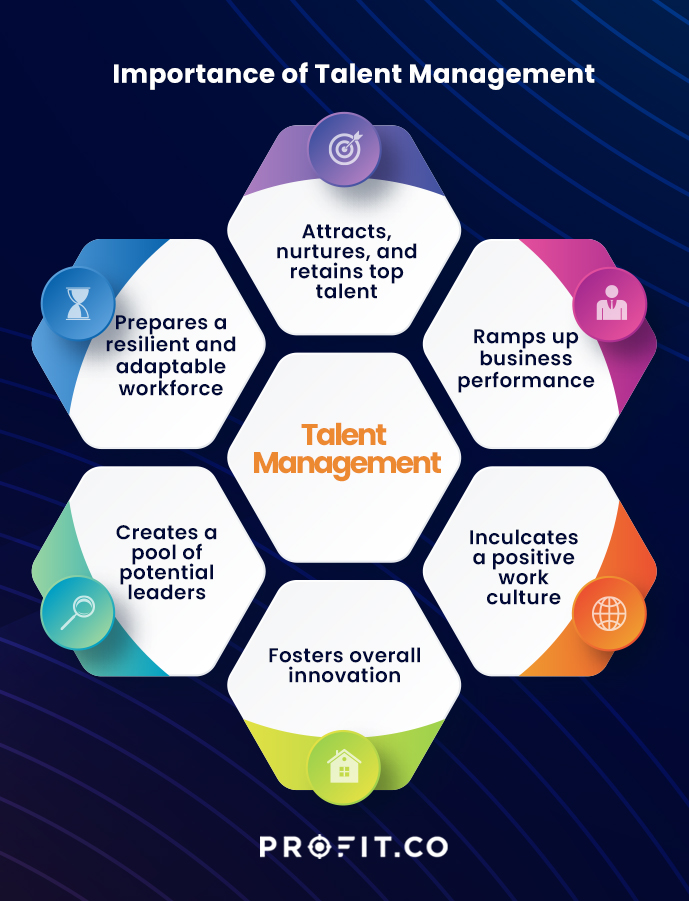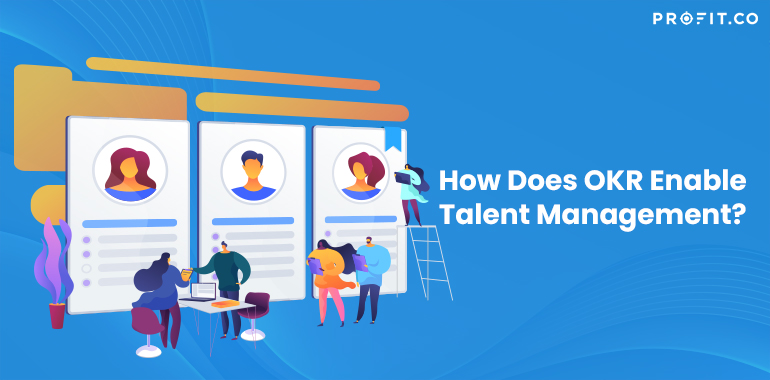In a highly competitive business scenario, having the best talent determines the success, agility, and adaptability of an organization. In order to have the top talent, an organization needs to be attractive enough for the top professionals to join. Talent management makes it possible for the organization to remain attractive to the top talent.
It identifies the best employees within the organization, nurtures and trains them, allows them to perform and shine, lets them enhance their leadership qualities, and enables them to maximize their contributions to help the organization achieve its objectives. Talent management paves way for recognition and career growth and fosters a positive work culture required for the organization to remain competitive and attractive for the top professionals. In short, it helps drive the importance of people management and helps in the long-term success of the organization.
One of the greatest talents of all is the talent to recognize and to develop talent in others
What is talent management?
Talent management is the process of attracting the best talent, developing their skills and abilities, engaging with them, and retaining the top employees, so that they can perform to their highest standards, maximize their performance and produce great results for the organization.
Talent management involves
- Identifying the best employees.
- Nurturing them with training and development.
- Keep them sharp with up-to-date knowledge in their respective work.
- Developing the leadership qualities of the best-performing employees.
- Creating a pool of promising leaders for the organization.
- Providing the top employees with the most amount of opportunities for career development.
- Creating a positive and inclusive work environment where employees thrive.
Importance of talent management
Talent management is vital for organizations as it helps them:
1. Attract, nurture, and retain top talent
Only the best teams are capable of attracting the greatest talent. Talent management helps to perpetuate the cycle of attracting top talent by retaining the best employees. Talent management achieves this by making sure that the employees get as many opportunities as possible for excellent career growth and development. As a result, the best employees are content with the organization and work there for a long time. This, in turn, helps to attract top talent. When an organization can attract, nurture and retain top talent, it can produce the best possible outcomes and enjoy a massive competitive edge.
2. Ramp up performance
Talent management ensures that the workforce is at the top of the game with all the skill sets required to carry out the tasks perfectly. It makes sure that the employees possess knowledge about the latest developments and best practices in their respective fields. Talent management keeps the skills and capabilities of their employees sharp and plays an important role in improving the overall performance and competitiveness of the organization.
3. Inculcate a positive work culture
Talent management creates a positive and inclusive work environment, and a great work culture that keeps employees engaged, feel valued, and motivated.
4. Foster innovation
When the workforce is highly skilled, motivated, and engaged, it brings the best out of the employees. It brings participation and lets everyone share unique perspectives and experiences, leading to increased creativity and innovation.
5. Create a pool of potential leaders
Talent management identifies employees with the greatest potential and nurtures their leadership qualities and skills. As a result, organizations can create a pool of potential leaders that the organization can tap into at any point of time in the future to drive the organization forward.
6. Be resilient and adaptable
Talent management helps organizations build a strong workforce that can remain resilient during testing times, adapt to rapid changes, and build success in an uncertain and rapidly changing business environment.

How does OKR help achieve talent management?
Talent management benefits from the use of the Objectives and Key Results framework for goal-setting. OKR introduces goal-oriented talent management and aligns the individuals and teams involved to the objectives of the organization.
For instance, if the organization decides to become more inclusive and have more women in key positions, then OKR ensures that the policy decision is captured in the talent management strategy down to the last level. When you have such an organizational objective, it automatically cascades to all those responsible for implementing it. This is because OKR, by nature, ensures alignment effective performance management
It further connects the outcomes created by the employees to the performance goals of the organization, creating a direct correlation between the employee performance and organizational growth, and methodically manages the performance of individual employees and the organization.
OKR makes sure that the talent management goals that are aimed at managing, developing, and retaining the talent within an organization are Specific, Measurable, Attainable, Relevant, and Time-bound (SMART). OKR also makes it possible to accurately track and measure the success of these talent management goals. When talent management goals are tracked and evaluated through performance evaluations, employee satisfaction surveys, and other metrics, you introduce a systematic approach to talent management, which gives you more control over your human capital management strategy. This results in gaining a significant competitive edge when it comes to having the best talent in the industry. OKR makes this possible.
Ready to start your OKR journey for Free?
Talent management OKRs cover a wide range of HR initiatives, including
- Recruiting top talent for the organization.
- Employee retention strategies for keeping employees motivated to stay with the organization so that the organization is seen as an excellent employer and remains attractive for the best candidates.
- Employee development measures provide growth opportunities for employees, training and development, upskilling opportunities, and ultimately a fruitful career.
- Evaluation of employee performance through performance management.
- Employee engagement to keep the employees engaged and motivated
- Promoting inclusion and diversity in the workplace.
Talent management OKR examples
1. Employee retention:
Objective: Reduce employee turnover by investing in talent management
Key Results:
- Increase the number of employee recognition awards given each month from 5% to 10%
- Conduct 3 in-house training programs in one quarter
- Increase employee satisfaction with the new performance-oriented bonus program from 77% to 90%
2. Employee engagement:
Objective: Increase employee engagement through innovative processes
Key Results:
- Have 1:1 discussions following the new intra-organizational social engagement process with 90% of employees
- Collect 10 new actionable ideas and innovations from every team by the end of Q1 2023.
- Increase the number of positive responses in the employee engagement survey from 70 % to 80%
3. Leadership Succession Planning
Objective: Create a succession plan and identify potential leaders within a year.
Key Results:
- Identify 10 high-potential employees in each department by Q1 2023.
- Conduct at least one leadership training program every month till Q4.
- Increase internal promotions to managerial positions from 5 % to 10% by Q4.
4. Diversity and inclusion
Objective: Foster a culture of diversity and inclusion
Key Results:
- Conduct a diversity and inclusion awareness program for 100% of employees by Q2.
- Allot 20% of newly created positions for the under-represented groups.
- Increase diversity in management positions by 5% by the end of 2023.
Frequently Asked Questions
- What are OKRs for talent management?
Talent management OKRs are OKRs set specifically for building, managing, nurturing, and retaining talent in an organization. They ensure that the organization has the right kind of talent with the right skills and competencies required to fulfill its business objectives. Talent management OKRs cover recruitment, employee development, performance management, employee retention, diversity, and inclusion.
- What is an example of OKR for hiring?
Objective: Attract and hire the best employees for the new product team
Key Result 1: Increase training and upskilling budget up to 20%.
Key Result 2: Identify the best employees in every team and promote at least one top candidate from each product team to the new team.
Key Result 3: Internally recruit 20% of top talent from other product teams.
- What does OKR mean in HR?
OKR, as a goal-setting framework, can be used in human resources (HR) to track progress, provide feedback, and achieve alignment toward goals in HR initiatives. Talent management, employee development, and career growth are some of the areas in HR that can benefit from OKR goal setting.

